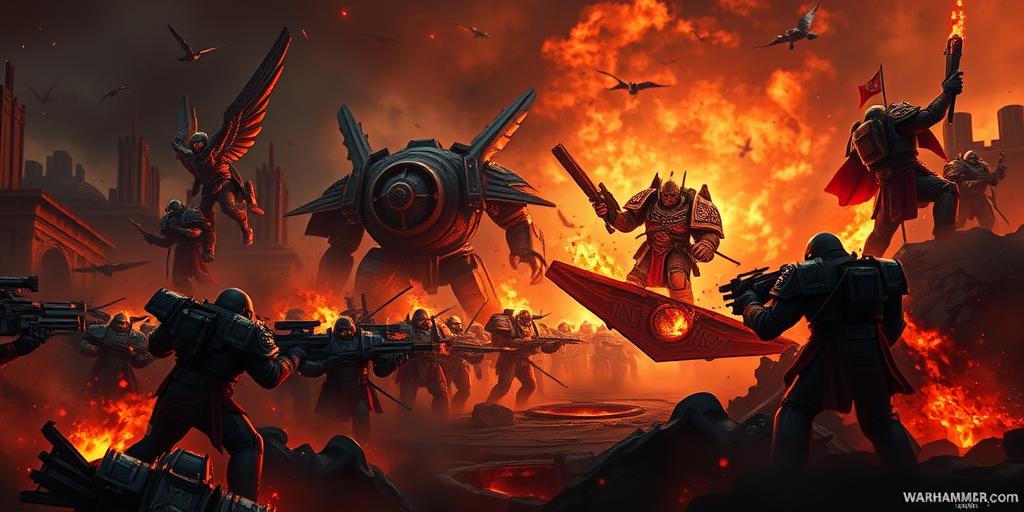The Horus Heresy is a pivotal event in the fictional universe of Warhammer 40,000, a grimdark science fantasy tabletop miniature wargame created by Games Workshop. It represents a galaxy-spanning civil war that forever altered the course of the Imperium of Man, leaving an indelible mark on its society, technology, and military structure. This article aims to explain the key aspects of this monumental conflict.
Background: The Great Crusade
In the aftermath of a period of strife known as the Age of Strife, the Emperor of Mankind emerged to unite humanity under a single banner. He launched the Great Crusade, a military campaign to reclaim the scattered human colonies across the galaxy and bring them under his rule. Leading this crusade were the Primarchs, twenty genetically engineered super-warriors created by the Emperor. Each Primarch was given command of a Space Marine Legion, massive armies of transhuman soldiers.
Seeds of Rebellion
Despite the successes of the Great Crusade, unease began to stir. Some Primarchs grew resentful of the Emperor's distant rule, while others fell prey to the temptations of Chaos, malevolent entities from another dimension that thrive on negative emotions and worship. Foremost among these was Horus, the Emperor's favored son and Warmaster of the Imperial forces. Horus, through a combination of pride, ambition, and manipulation by Chaos forces, came to believe that the Emperor was holding humanity back from its true potential.
The Isstvan III Atrocity
The opening act of the Horus Heresy was the betrayal at Isstvan III. Horus, now secretly aligned with Chaos, ordered loyalist elements within four Space Marine Legions – the Sons of Horus, World Eaters, Emperor's Children, and Death Guard – to Isstvan III, a world deemed to be in rebellion. Once these loyalists were planetside, Horus unleashed a devastating virus bomb, followed by a full-scale assault, resulting in a massacre of unimaginable proportions.
The Dropsite Massacre
The next major engagement occurred at Isstvan V, where seven Space Marine Legions loyal to the Emperor arrived to confront Horus. However, four of these Legions – the Iron Warriors, Night Lords, Word Bearers, and Alpha Legion – had secretly turned to Chaos. The loyalist Legions – the Iron Hands, Raven Guard, and Salamanders – were ambushed and decimated in a brutal battle known as the Dropsite Massacre. This event marked a turning point in the Heresy, solidifying the lines of division and plunging the galaxy into full-scale war.
The War in the Galaxy
The Horus Heresy raged across the galaxy for seven years, with battles fought on countless worlds. Key engagements included the Siege of Terra, where Horus launched a direct assault on the Imperial Palace on Terra (Earth), the Thramas Crusade, a brutal campaign fought between the Dark Angels and Night Lords Legions, and the Battle of Calth, a devastating attack by the Word Bearers on the Ultramarines.
The Siege of Terra
The culmination of the Horus Heresy was the Siege of Terra. Horus, at the head of a vast traitor army, besieged the Imperial Palace, the heart of the Imperium. The defenses were strong, but the traitors were relentless. After months of grueling warfare, Horus and the Emperor finally met in single combat aboard Horus's flagship, the Vengeful Spirit.
The Emperor's Victory and Sacrifice
In a desperate battle, the Emperor defeated Horus, but at a terrible cost. The Emperor was mortally wounded, and while Horus was slain, the Emperor's injuries were so severe that he had to be interred within the Golden Throne, a life-support machine that sustains his existence. The Imperium was saved, but at the price of its leader's active presence.
Aftermath and Legacy
Following the Horus Heresy, the Imperium underwent significant changes. The Space Marine Legions were broken down into smaller Chapters to prevent any single commander from wielding too much power. The Inquisition was formed to root out heresy and corruption within the Imperium. The Emperor became a figure of worship, and the Imperium embraced a zealous form of religious devotion. The scars of the Horus Heresy remain to this day, shaping the grim and unforgiving nature of the 41st millennium.
Conclusion
The Horus Heresy is a tragic tale of betrayal, ambition, and the corrupting influence of Chaos. It serves as a cautionary reminder of the fragility of even the most powerful empires and the importance of vigilance against internal threats. The events of the Heresy continue to resonate throughout the Warhammer 40,000 universe, shaping the conflicts and ideologies of its many factions.









